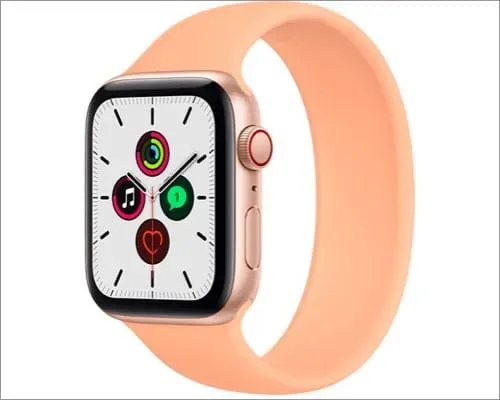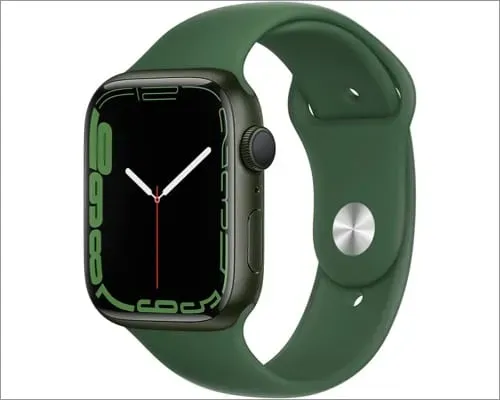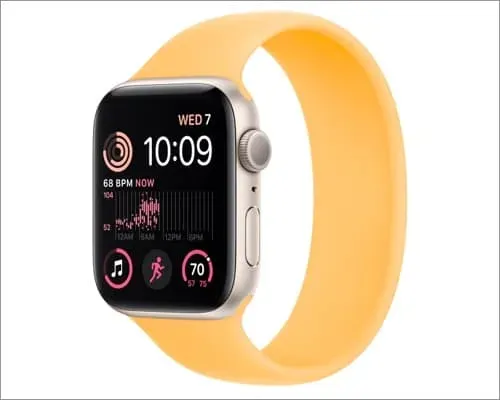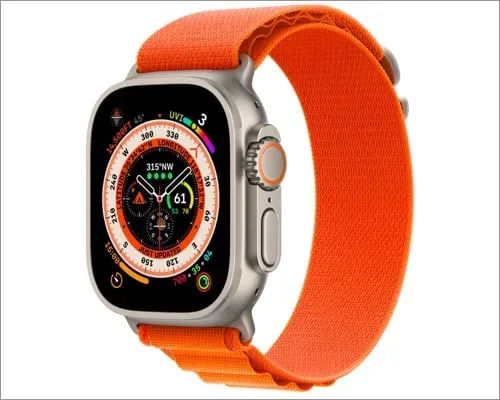Apple Watch history: 7 years and more…

The Apple Watch is one of the best-selling smartwatches. It even surpassed the Swiss watch industry, a testament to its impressive success. And rightly so, in just seven years it has helped and touched so many lives.
Taking another leap, the 2022 Apple Watch, i.e. Apple Watch Ultra, Apple Watch Series 8 and SE 2, is rushing (both literally and lateral) to help, inspire and save lives.
This is especially interesting given that the Apple Watch didn’t immediately see success. It had almost no customers when it was first launched in 2015. What has changed in half a century to make it a must-have? Let’s find out by looking at a brief history of the Apple Watch models.
- The evolution of the Apple Watch
- 2015: Apple Watch Series 1
- 2016: Apple Watch Series 2
- 2017: Apple Watch Series 3
- 2018: Apple Watch Series 4
- 2019: Apple Watch Series 5
- 2020: Apple Watch Series 6 and Apple Watch SE
- 2021: Apple Watch Series 7
- 2022: Apple Watch Series 8, Apple Watch SE and Apple Watch Ultra
- What’s next for the Apple Watch?
The evolution of the Apple Watch
The Apple Watch was the first new product line released by Tim Cook. When it finally unveiled it in April 2015, it ushered in a new era for the tech giant as it entered the fledgling smartwatch and wearable market.
The purpose of the Apple Watch was to help people get rid of their iPhones while still allowing them to stay connected to the important things they need in our digital age. It was a device that could not be used for hours, like smartphones.
Instead, it will filter out noise and only provide important information. It was a revolutionary step forward because before that, Apple had spent three decades developing devices that kept our attention for as long as possible.
So from the very beginning, the Apple Watch was conceived as a device that would help us stay connected in less invasive ways than our smartphones. Since then, each iteration has placed increasing emphasis on improving health and wellness. Let’s take a look at the changes over the years:
2015: Apple Watch Series 1 – revolutionary changes

The Apple Watch has departed from the company’s usual practice of offering a narrow range of products. Instead, the original Apple Watch had three options: Sport, Watch, and Edition.
While the $349 Sport aluminum watch performed the same functions as the $17,000 premium 18K gold version, they were completely different products designed for different users.
Apple took a cue from the watch industry to offer personalization and options for a wide variety of tastes and budgets. As such, it offered different sizes, materials, straps, and internal customization through dials and complications.
Fun fact: If you’ve ever wondered why widgets on the Apple Watch are called “complications,”this term, used in high-end watchmaking, refers to the functions that the watch performs in addition to displaying the hour and minute.
All three variants were 38mm and 42mm with Bluetooth and Wi-Fi capabilities. Features included digital crown, digital touch, force touch, multi-touch, and side button. It also had a heart rate sensor and was, of course, designed to integrate with iOS.
Other features were either specific to Apple, such as Siri, FaceTime, etc., or specifically designed for functionality. The latter included an email reader (Read Mail), a GPS navigator (Transit), and health and fitness trackers.
However, these features can quickly drain the watch’s battery, rendering it useless. While it was possible to put the Apple Watch into basic watch mode while charging, doing so interrupted the activity tracking, disrupting the user experience.
Another issue with the Apple Watch that has been prevalent these days is its dependence on maintaining a strong connection with a paired iPhone. This led to speculation that the watch was an unnecessary accessory if you had to carry your iPhone with you anyway.
2016: Apple Watch Series 2 – Hello GPS!

The 2016 version of the Apple Watch has some key improvements. Perhaps most important was the addition of GPS, which means you can use it to navigate even if you don’t have an iPhone.
While the fitness tracking features remained the same, the second generation Apple Watch was also water resistant to 50 meters, so it could be worn while swimming. It also had a brighter display and a faster processor. Unfortunately, short battery life prevailed.
2017: Apple Watch Series 3 – third time – lovely

2017 was the year the Apple Watch finally took off and cemented its status as more than just an addition to the iPhone. Series 3 is the oldest Apple Watch (still in production in 2021 and available in various price ranges).
It was a significant step up from the Series 2 with a faster Apple S3 processor, updated Bluetooth connectivity, more RAM and a Siri that can speak (like on the iPhone) rather than just respond to commands.
In addition, it comes in two models, one with GPS and cellular, and the other with GPS. Both have a barometric altimeter to provide even greater navigational capability. The cellular version can also make phone calls if the watch is connected to the same data plan as the iPhone.
2018: Apple Watch Series 4 – winning hearts

September 2018 gave us the Apple Watch Series 4 in different styles with different materials, straps and sizes. For example, you can get a 40mm gray aluminum case with a matching strap, or go for something bigger and brighter with a 44mm gold case and a pink strap.
In addition to the customizable exterior, you’ll get a powerful 64-bit dual-core processor inside. This greatly improved the speed and fluidity of watchOS, allowing you to run more complex apps. This improved functionality has solidified the Apple Watch’s position as a must-have device and not just an extra accessory.
Other improvements in the Apple Watch 4 included improved Bluetooth, improved motion and location sensors (including a gyroscope, accelerometer, and altimeter), and more advanced health and fitness tracking. It introduced fall detection, a potentially life-saving feature for the elderly.
The highlight was heart monitoring technology, which included testing an electrocardiogram, known as an ECG. Typically, such electrocardiograms are done in hospitals using a ten-pin electrical assembly. The Apple Watch achieves this by using a single pin node, providing critical health data.
This ECG app is also supported, though not approved, by the American Heart Association as it has the potential to speed up the diagnosis and treatment of heart disease and prevent heart emergencies.
2019: Apple Watch Series 5 – always-on display

The highlight of the Apple Watch Series 5 was the always-on display. There were no other significant changes. The always-on display allowed you to flaunt the watch face and advanced features you had configured. While battery life was an issue, it could be saved because the display automatically adjusted to ambient mode when you weren’t looking at it.
Available in two sizes, 40mm and 44mm, the ceramic and titanium cases were new additions to the aluminum and stainless steel options.
2020: Apple Watch Series 6 – health comes to the fore

The latest Apple Watch Series 6 is the perfect smartwatch for a healthy lifestyle. It’s available in stainless steel, titanium, and completely recycled aluminum with an always-on Retina display. It is waterproof to 165 feet and comes with a blood oxygen sensor.
Apple Watch SE – Pocket

The Apple Watch SE launched alongside the Apple Watch Series 6 boasts similar features at an affordable price. It is powered by the S5 chipset while the Series 6 comes with the latest S6 chipset.
It also lacks the always-on display, ECG, and blood oxygen monitor. But that doesn’t stop it from being one of the best wearables, especially for tracking physical activity. In addition, single-loop ribbons made of silicone or woven yarn give the product a modern look.
2021: Apple Watch Series 7 – bigger and brighter display

Released in September 2021, the Series 7 features a sharp edge-to-edge display. The 41mm and 45mm displays are 40% smaller, which increases the viewable portion of the screen by 20%. Plus, it’s 70% brighter in always-on mode. Thanks to the increased real estate, we got features such as:
- Full-size QWERTY on-screen keyboard
- Calculator now has large buttons
- Displaying text messages
In addition, Apple has made this model more durable and dustproof with IP6X certification. Along with this, the model comes with three different build materials such as aluminum, stainless steel and titanium.
Apple has used the new S7 SiP processor and the same core processor as the Series 6. Therefore, the display capabilities, fall detection and other features are upgraded to the next level. You will also see an optimized battery with 33% faster charging. Consequently, the Apple Watch can track eight hours of sleep with just eight minutes of charging and reach 80% within 45 minutes.
2022: Apple Watch Series 8 – no more, but definitely better

The Apple Watch Series 8 was released on September 7, 2022 with many new features. A new temperature sensor in the Apple Watch Series 8 promises to improve women’s health. According to Apple, sensors on the bottom of the watch and right below the touchscreen can detect temperature changes as small as 0.1 degrees Celsius every 5 seconds.
Along with this, the advanced cycle tracking feature provides a near-accurate estimate of ovulation. Thus, the new automatic backdated ovulation alerts will be useful for couples when planning a family. Changes to the cycle tracking app in watchOS 9 and iOS 16 will also alert users to irregular menstrual cycles.
Apple emphasized that all data is end-to-end encrypted. Another new feature on the Apple Watch Series 8 is crash detection. Apple has added two new motion sensors: accelerometers and gyroscopes to help you determine if you’ve been in a serious car accident. It can measure the frontal, side, rear impact and rollover force of any vehicle. And all crash detection data will be stored only on your watch.
Apple Watch also adopts an advanced power saving mode. It will turn off features like the always-on display and only allow emergency services and other important features. Thus, the total battery life will be increased to 36 hours. On Series 4 and later watches, this mode will be available in Watch OS 9.
Available in a wide variety of new colors and ranges, Series 8 watches are priced at $399 for regular Wi-Fi and $499 for Cellular Plus Wi-Fi.
Apple Watch SE 2 – more features at an affordable price

The second-generation Apple Watch SE provides all the essential features of an Apple Watch at a lower price. Apple has developed a new nylon composite material to match the color of the back cover: Midnight, Starlight and Silver. The S8 processor and motion sensors like the Apple Watch Series 8 will make the Apple Watch SE 2 20% faster and include crash detection.
SE 2 will also allow international roaming by connecting to an iPhone roaming plan. The usual features of the original SE 2, including an OLED Retina display, optical heart rate sensor, fall detection, emergency SOS, and water resistance up to 50 meters, are still present.
Parents who want to communicate with school-age kids without being tied down to an iPhone often opt for the cellular version of the SE. Apple has revealed that the new SE will have a family setup feature. This way you can connect multiple Apple Watches to your iPhone. The SE 2 screen is 30% larger than the Series 3.
The new SE will be $30 cheaper than the original SE: $249 for the GPS variant and $299 for the cellular variant.
Apple Watch Ultra is the ultimate fitness tracker

The unrivaled, high-quality Apple Watch Ultra has ushered in a new era in Apple Watch history. The watch is a new style with a large display and a 49mm titanium case specially crafted for outdoor activities and exploration. 2000 nit display with sapphire crystal for better visibility.
For outdoor athletes, it is essential that pushers and crowns function while wearing gloves. So, Apple updated the Digital Crown with Night Mode and added a new Action button on the side with lots of features. Like the Apple Watch Series 8, it also has an advanced power saving mode that provides over 36 hours of battery life.
In addition, upcoming battery optimizations will extend battery life by more than 60 hours with GPS and heart rate monitoring. Apple has improved GPS with a brand new L1 + L5 frequency. In addition, you can use the WayFinder feature to launch a return route and alert others with an 86 decibel siren.
In addition to adventures on land and sports, Apple Watch Ultra is also equipped for scuba diving. It is WR 100 water resistant and EN 13319 certified. Under water, a new depth app called Oceanic+ displays time, depth and temperature at a glance. The best part is that all dive data will be saved for future reference.
You’ll get three new range options along with all the existing features: Alpine, Trail and Ocean. They are made to withstand “long runs, hard drops and choppy currents”and are adapted to different conditions. The Apple Watch Ultra starts at $799.
You don’t need it, but you want it!
The success of the Apple Watch over the past six years has dispelled any doubts about its usefulness. But it’s fair to say that this is not a technology that anyone necessarily needs. However, like other Apple products, it draws you in with its superior experience.
Most, if not all, tech enthusiasts and Apple users crave this product for how it improves your lifestyle by reducing your dependency on your iPhone when you’re out and about.
One of the most popular features is haptic touch, which uses light touches and vibrations on your wrist to keep you informed of everything from incoming calls and messages to reminders, health alerts, and more.
In addition, aesthetics has a lot to do with attractiveness. Even in 2015, the Apple Watch was far ahead of similar wearable devices. In addition, the interchangeable watch strap system and internal customization make it a personal device.
What else? There have been several cases where the Apple Watch has saved people’s lives.
What’s next for the Apple Watch?
Apple didn’t invent the smartwatch, but in six short years it has become synonymous with the device. This shows just how much the Apple Watch has been a game changer.
While the first generation wasn’t an instant success, it paved the way for the current iteration, which is faster, thinner, brighter, and, of course, smarter. What’s more, the watch is Apple’s contribution to healthcare, considering how it has helped save so many lives.
Time flies!
So while there are plenty of competitors in the sector, the Apple Watch is in a league of its own with deep iOS integration and features that are hard to beat. Little is known about what the next Apple Watch might bring, but it’s sure to pave the way when it comes to helping you take charge of your health, fitness, and life in general, right from your wrist.
The watch has become an additional addition to your main device, which strikes the perfect balance between staying connected and helping you focus on what matters most. This should continue to appeal to iPhone users as watches become even more advanced in the future.
Leave a Reply